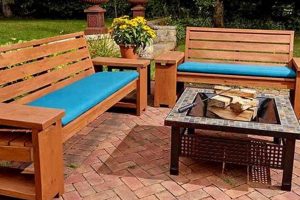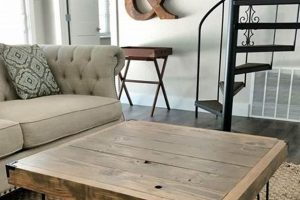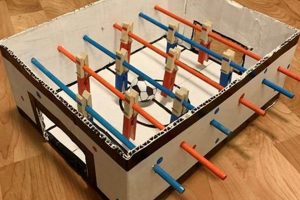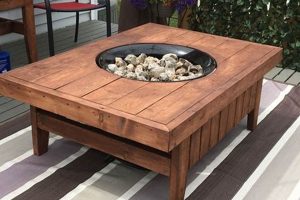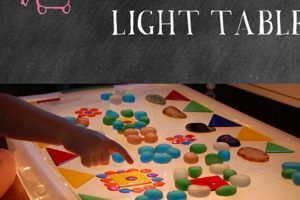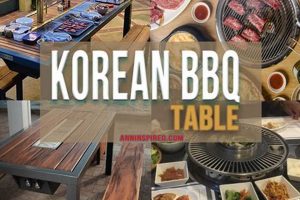Individually crafted coverings for tables, fashioned by the table owner or enthusiast, are designed to protect the surface from heat, spills, and scratches while simultaneously enhancing the aesthetic appeal of the dining area or workspace. These handmade creations can range from simple fabric squares to intricate woven designs, reflecting personal style and resourcefulness.
The advantages of creating custom table protectors are multifaceted. Economic benefits are realized through the utilization of repurposed materials or the avoidance of retail markups. Personalized design allows for perfect coordination with existing decor. Historical precedents exist in various cultures where handmade textiles served functional and decorative purposes within the home, signifying skill and domestic artistry. The practice fosters creativity and offers a sustainable alternative to mass-produced goods.
The following sections will explore specific materials suitable for their construction, detailing various techniques and design possibilities, and outlining essential considerations for durability and maintenance.
Construction Pointers for Bespoke Table Protectors
The subsequent recommendations provide guidance for individuals embarking on the creation of personalized table surface coverings. Careful consideration of these factors will contribute to a durable and aesthetically pleasing final product.
Tip 1: Material Selection is Paramount: Prioritize materials based on heat resistance, durability, and ease of cleaning. Cork, thick cotton fabrics, and certain synthetic materials demonstrate suitable properties. Thoroughly research material specifications prior to commencement.
Tip 2: Precise Measurements are Essential: Accurately measure the table surface to ensure adequate coverage. Account for potential shrinkage or stretching of the chosen material, particularly when working with natural fibers. Allow for a slight overhang if desired.
Tip 3: Consider the Substrate: If utilizing thinner fabrics, a backing material provides added protection and stability. Felt, non-slip rubber, or a layer of interfacing can enhance the overall quality and longevity of the finished item.
Tip 4: Secure Edges are Critical: The edges of the surface covering are vulnerable to fraying and wear. Employ techniques such as hemming, binding, or serging to create a durable and aesthetically pleasing finish. Mitered corners provide a professional appearance.
Tip 5: Emphasize Heat Resistance: For hot dishes, incorporate heat-resistant elements. Cork, trivet inserts, or multiple layers of heat-resistant fabric offer increased protection and prevent damage to the table surface.
Tip 6: Incorporate Non-Slip Elements: To prevent slippage on the table, consider adding non-slip elements. This can be achieved through the use of rubberized coatings, textured fabrics, or strategically placed non-slip pads on the underside.
Tip 7: Prioritize Ease of Cleaning: Select materials and finishes that are easy to clean and maintain. Consider the potential for spills and stains, and choose materials that can withstand regular cleaning without degradation. Regular cleaning will prolong the life of the item.
Adherence to these recommendations will result in a functional and visually appealing table surface protector, offering both protection and aesthetic enhancement. The creation of these bespoke items offers a cost-effective and personalized solution for preserving table surfaces.
The following section will address specific design techniques for enhancing the aesthetic appeal of these items.
1. Material Heat Resistance
Material heat resistance is a critical consideration in the creation of self-made table protectors. The capacity of a material to withstand high temperatures without degradation directly impacts the functionality and longevity of the table covering. Inadequate heat resistance can lead to damage of the table surface, rendering the covering ineffective. Therefore, careful selection of materials based on their thermal properties is paramount.
- Heat Transfer Properties
Certain materials inherently possess lower heat transfer rates. For instance, cork exhibits a significantly lower thermal conductivity compared to metal or thin fabric. Utilizing such materials minimizes the amount of heat reaching the table surface, thereby preventing heat-related damage such as scorching or discoloration. Incorporating air gaps or insulated layers also contributes to reduced heat transfer.
- Melting and Decomposition Temperatures
The melting point or decomposition temperature of a chosen material must exceed the expected maximum temperature of items placed upon it. Plastics, for instance, can deform or melt under relatively low heat. Natural fibers, while generally more heat-resistant than some synthetics, may char or ignite at higher temperatures. Comprehensive material testing is advised to ascertain thermal stability.
- Material Thickness and Density
Increased material thickness and density generally correlate with improved heat resistance. A thicker layer of cork, for example, provides a greater barrier against heat transfer than a thin layer. Dense materials, such as tightly woven fabrics or solid wood, offer greater thermal mass, delaying the rate at which heat penetrates to the underlying table surface.
- Protective Coatings and Treatments
The application of heat-resistant coatings or treatments can enhance the thermal performance of certain materials. Flame retardants, for instance, can increase the ignition temperature of fabrics. Similarly, heat-reflective coatings can reduce the amount of radiant heat absorbed by the surface protector. These treatments are often applied to materials that may otherwise be unsuitable for use with hot items.
The multifaceted nature of material heat resistance underscores its significance in the design of personalized table coverings. Prudent material selection, informed by an understanding of thermal properties, is essential for ensuring both the protection of the table surface and the prolonged usability of the created item. Failure to adequately address this consideration can result in functional failure and potential damage to valuable furniture.
2. Size and Shape Accuracy
The dimensional precision of custom-made table protectors is paramount to their functionality and aesthetic integration within a given space. Inaccurate sizing or shaping compromises their intended purpose of surface protection and detracts from the overall visual appeal. A thorough understanding of these factors is therefore essential for any individual undertaking such a project.
- Protection Effectiveness
A table protector’s primary function is to shield the table from damage caused by heat, spills, or scratches. Inaccurate dimensions render this protection incomplete. Undersized table protectors leave portions of the table exposed, negating their intended benefit. Oversized protectors, conversely, may drape awkwardly or present a tripping hazard, particularly if they extend significantly beyond the table’s edge.
- Aesthetic Harmony
The visual integration of a table protector with its surroundings contributes to the overall aesthetic harmony of the space. A well-proportioned and accurately shaped protector complements the table’s design and enhances the room’s visual appeal. Conversely, a poorly sized or shaped protector can appear out of place, detracting from the room’s aesthetic and suggesting a lack of attention to detail. Custom shapes, designed to match unique table designs, require even greater accuracy to maintain visual coherence.
- Ease of Use and Maintenance
Proper size and shape contribute to the ease of use and maintenance of table protectors. Accurately sized protectors remain securely in place during use, preventing slippage or shifting. This stability facilitates easier cleaning and reduces the likelihood of accidental spills. An ill-fitting protector may require constant readjustment, increasing inconvenience and potentially leading to premature wear and tear.
- Material Utilization Efficiency
Precise cutting and shaping minimize material waste, contributing to both cost-effectiveness and environmental responsibility. Accurate measurements allow for efficient layout and cutting, reducing the amount of scrap material generated during the creation process. This is particularly relevant when working with costly or limited-quantity materials. Furthermore, accurate shaping reduces the need for extensive trimming or alterations, saving time and effort.
These considerations collectively demonstrate the critical importance of size and shape accuracy in the creation of custom table protectors. Neglecting these factors compromises the effectiveness, aesthetic appeal, and long-term usability of the finished product. Achieving dimensional precision requires careful measurement, meticulous cutting, and a thorough understanding of the chosen materials’ properties.
3. Edge Durability Enhancement
The longevity and aesthetic appeal of self-made table protectors are directly contingent upon the implementation of effective edge durability enhancement techniques. The edges of these items are inherently vulnerable to fraying, abrasion, and general wear, which can compromise both their structural integrity and visual presentation. Addressing this vulnerability is therefore a crucial aspect of their creation.
- Binding Techniques
Binding the edges with fabric or bias tape constitutes a common and effective method of reinforcement. This technique involves encasing the raw edge of the material within a folded strip of fabric, which is then sewn securely in place. This not only prevents fraying but also adds a decorative element to the finished piece. For instance, applying a contrasting color of bias tape to a simple fabric protector can enhance its visual interest while simultaneously reinforcing the edge.
- Hemming Procedures
Hemming involves folding the raw edge of the material over itself and securing it with stitching. This creates a clean and durable edge that resists fraying and unraveling. Different hemming styles, such as rolled hems or blind hems, can be employed depending on the desired aesthetic and the type of material being used. A narrow rolled hem, for example, provides a subtle and unobtrusive edge finish for delicate fabrics.
- Serging Applications
Serging, also known as overlocking, utilizes a specialized sewing machine to bind the edge of the fabric with a series of looped stitches. This technique creates a robust and professional-looking edge that is highly resistant to fraying. Serging is particularly well-suited for knit fabrics, which are prone to unraveling. A serged edge also adds a degree of elasticity, allowing the protector to stretch slightly without compromising its structural integrity.
- Edge Coating Treatments
The application of edge-sealing products or coatings can provide an additional layer of protection against fraying and abrasion. These treatments typically involve applying a liquid or gel substance to the raw edge of the material, which then hardens to create a barrier against wear. Fabric glue or specialized edge sealants are examples of such products. This method is particularly useful for materials that are difficult to sew or bind, such as certain types of synthetic fabrics.
The application of these edge durability enhancement techniques directly contributes to the overall quality and lifespan of homemade table protectors. By addressing the inherent vulnerability of the edges, creators can ensure that their projects remain both functional and visually appealing for an extended period. The choice of technique depends on factors such as the type of material used, the desired aesthetic, and the level of durability required.
4. Surface Stain Resistance
Surface stain resistance, as a critical attribute of individually crafted table coverings, directly influences their functionality, longevity, and aesthetic value. The susceptibility of a table mat to staining affects its ability to protect the underlying table surface and maintain a presentable appearance. The selection of materials and application of protective treatments fundamentally determine the degree of stain resistance achieved. Examples include the use of treated cotton fabrics that repel liquids or the application of stain-resistant coatings to porous materials like cork. The practical significance lies in minimizing maintenance efforts and preserving the table mat’s visual appeal despite exposure to potential staining agents. The consequences of inadequate stain resistance are visible in the form of permanent discoloration, requiring frequent replacement of the mat and ultimately increasing long-term costs.
Further analysis reveals that the type of staining agent necessitates tailored strategies. For instance, oil-based stains require materials with hydrophobic properties, while water-based stains necessitate materials with limited absorbency. The application of sealant compounds or specialized coatings represents a common approach to enhancing resistance against diverse staining agents. Practical applications include the creation of placements specifically designed for children’s use, employing laminated fabrics that withstand spills and food stains. The choice between natural and synthetic materials presents a trade-off, with certain synthetics offering superior stain resistance at the expense of environmental sustainability. Thorough testing of materials before fabrication is essential to ensure compatibility with common staining agents.
In summary, surface stain resistance constitutes a non-negotiable attribute of homemade table protectors. Achieving adequate stain resistance requires careful material selection, appropriate protective treatments, and an understanding of potential staining agents. While challenges exist in balancing stain resistance with other desirable properties such as heat resistance and aesthetic appeal, the importance of this attribute cannot be overstated. Its presence ensures the long-term functionality, durability, and aesthetic value of personalized table surface coverings, while its absence results in premature degradation and increased maintenance burdens.
5. Aesthetic Design Integration
Aesthetic design integration, in the context of “diy table mats,” represents the deliberate alignment of visual characteristics with the surrounding environment and user preferences. The success of handcrafted table coverings hinges not solely on their protective function, but also on their ability to harmonize with the existing decor and contribute to the overall ambiance of the space. Failure to consider aesthetic integration can result in a visually jarring element that detracts from the room’s cohesive design. Examples include utilizing color palettes that complement existing furniture, incorporating patterns that echo architectural details, or employing textures that enhance the tactile experience of the dining or workspace.
The selection of materials, patterns, and construction techniques plays a pivotal role in achieving successful aesthetic integration. For example, a minimalist modern dining room might benefit from table mats constructed from neutral-toned linen with clean geometric patterns. Conversely, a rustic farmhouse kitchen could be enhanced by table mats crafted from reclaimed wood or textured cotton with floral motifs. The scale of the pattern should also be proportional to the table size and surrounding elements. Furthermore, consider the overall design language of the space: is it formal or informal, modern or traditional? The table mats should align with this existing language to create a sense of visual unity. Attention to detail, such as the precise alignment of patterns and the quality of the finishing, contributes to a refined and aesthetically pleasing final product. The design choices reflect the user’s individual taste and aesthetic values; the user can also choose based on festive season or any event.
In conclusion, aesthetic design integration is an indispensable component of crafting personalized table coverings. The careful consideration of color, pattern, texture, and overall design language transforms these functional items into elements that enhance the visual appeal and contribute to the overall ambiance of the space. Addressing this aspect is critical for achieving a cohesive and harmonious interior design scheme and results in high-quality, personalized table placements. The main challenges lies in balancing personal preference with the style of the room.
6. Non-Slip Functionality
Non-slip functionality constitutes a critical performance parameter for crafted table coverings, impacting both user safety and table surface preservation. The incorporation of measures to prevent slippage directly mitigates the risk of accidental displacement, which can lead to spills, damage to dishware, and potential injury. The following points elaborate on key facets of non-slip functionality in relation to “diy table mats”.
- Material Selection for Enhanced Friction
The choice of materials directly influences the coefficient of friction between the table covering and the underlying surface. Natural rubber, silicone, and certain textured fabrics exhibit inherently high frictional properties. The application of these materials to the underside of a self-made table mat significantly reduces the likelihood of unwanted movement. Examples include the lamination of a fabric mat with a thin layer of rubber or the strategic placement of silicone dots. This selection directly impacts stability.
- Textural Considerations for Surface Adhesion
Surface texture plays a significant role in promoting adhesion. Smooth, polished surfaces offer minimal resistance to slippage, while rough or textured surfaces provide increased grip. The incorporation of texture on the underside of table coverings can be achieved through various methods, such as embossing, printing with textured inks, or the addition of non-slip coatings. An example is creating a textured pattern on the bottom of a cork table mat to reduce its tendency to slide on a glass table.
- Weight Distribution and Stability
Even weight distribution across the table covering contributes to overall stability. Uneven weight distribution can create leverage points that facilitate slippage. The strategic placement of heavier materials or the addition of weighting elements, such as small metal disks, can improve stability. This consideration is particularly relevant for larger table coverings or those with complex shapes that may be prone to tilting or shifting. Securing the product prevents accidents and injury.
- Adhesive Solutions for Temporary Fixation
The use of temporary adhesive solutions, such as removable adhesive sprays or double-sided tape, provides an alternative approach to achieving non-slip functionality. These solutions create a temporary bond between the table covering and the table surface, preventing movement without causing permanent damage. This method is particularly useful for delicate table surfaces or when a more permanent non-slip solution is not desired. Caution is advised, ensuring that the adhesive does not damage the table’s surface.
The facets outlined above underscore the importance of deliberate design and material selection in achieving effective non-slip functionality in crafted table coverings. By addressing these considerations, creators can enhance the safety, stability, and overall utility of their products. Further enhancement of product safety can be achieved through consumer education, emphasizing proper product use. All points ensures quality and effective functionality.
7. Cleaning Process Simplicity
The ease with which crafted table coverings can be cleaned represents a critical determinant of their long-term practicality and user satisfaction. The connection between “diy table mats” and “Cleaning Process Simplicity” is fundamentally causal: the materials and construction techniques employed directly dictate the effort required for maintenance. A design prioritizing this simplicity extends the lifespan of the product by encouraging regular cleaning, thus preventing the accumulation of stains and debris that could otherwise necessitate premature replacement. For example, a table covering constructed from a non-absorbent, wipeable material like vinyl inherently offers a more straightforward cleaning process compared to one made from intricately woven, untreated cotton.
Further analysis reveals that the cleaning protocol impacts both the visual appeal and hygienic state of the covering. A simple cleaning process promotes frequent cleaning, which in turn maintains the covering’s aesthetic integrity and prevents the proliferation of bacteria and mold. Consider the practical application of a child’s placemat: a surface that can be quickly wiped clean after each meal minimizes the risk of foodborne illnesses and preserves the mat’s visual appeal, thereby reducing the burden on caregivers. Conversely, table coverings requiring complex cleaning procedures, such as hand-washing or specialized stain removal techniques, are less likely to be cleaned regularly, leading to a gradual deterioration of their appearance and hygienic condition.
In summary, “Cleaning Process Simplicity” is an integral component of successful “diy table mats.” The ability to easily maintain a table covering significantly contributes to its overall value and extends its usable lifespan. Challenges arise in balancing cleaning ease with other desirable attributes such as aesthetic appeal and environmental sustainability. However, prioritizing simplicity in the cleaning process yields a product that is both functional and user-friendly, promoting long-term satisfaction and minimizing the burden of maintenance. Therefore, the design, construction and material considerations are all important.
Frequently Asked Questions About Diy Table Mats
The following questions address common inquiries regarding the creation and maintenance of custom-made table surface protectors. These answers provide clarification on various aspects of the topic.
Question 1: What materials are most suitable for creating heat-resistant table mats?
Cork, thick cotton fabrics treated with heat-resistant coatings, and silicone are viable options. The choice depends on the desired aesthetic and the level of heat protection required. Conduct thorough research on material specifications prior to construction.
Question 2: How can one ensure accurate sizing when creating bespoke table coverings?
Precise measurements of the table surface are essential. Account for potential shrinkage or stretching of the chosen material. Consider creating a template to ensure accuracy, especially for irregularly shaped tables.
Question 3: What techniques effectively prevent fraying along the edges of handmade table protectors?
Hemming, binding with fabric or bias tape, and serging are proven methods. The selected technique depends on the material type and desired aesthetic finish. Secure stitching is crucial for long-term durability.
Question 4: How does one enhance the stain resistance of custom table mats?
Employ stain-resistant fabrics or apply protective coatings to the surface. Consider the potential for spills and choose materials that can withstand regular cleaning without degradation. Pre-treating fabrics with stain repellents is also beneficial.
Question 5: What methods can be employed to ensure that handmade table coverings remain securely in place?
Attaching non-slip pads to the underside, applying a rubberized coating, or using textured fabrics can effectively prevent slippage. Consider the weight of the table covering and adjust the non-slip measures accordingly.
Question 6: How should diy table mats be cleaned to prolong their lifespan and maintain their appearance?
Follow the manufacturer’s instructions for the chosen materials. Regularly wipe down the surface with a damp cloth and mild detergent. Avoid harsh chemicals or abrasive cleaners, which can damage the material. Promptly address spills to prevent staining.
These answers provide guidance for creating and maintaining durable and aesthetically pleasing table surface protectors. Careful consideration of these points will contribute to a successful project.
The subsequent section will discuss specific design ideas for enhancing the visual appeal of custom table coverings.
Conclusion
The preceding analysis has elucidated the multifaceted considerations inherent in the creation of “diy table mats.” From material selection and dimensional accuracy to edge durability, stain resistance, aesthetic integration, non-slip functionality, and ease of cleaning, each element contributes significantly to the overall value and longevity of the finished product. Successful implementation requires a comprehensive understanding of these parameters and a commitment to meticulous execution.
The pursuit of personalized table coverings transcends mere economic considerations. It represents a deliberate act of creative expression and a commitment to enhancing the functional and aesthetic qualities of the domestic environment. Ongoing research and experimentation with novel materials and techniques will undoubtedly yield further advancements in the realm of handcrafted table protection, empowering individuals to create bespoke solutions that reflect their unique needs and preferences. Continued refinement of design and construction methods promises a future where personalized table coverings seamlessly integrate into the fabric of daily life, providing both practical utility and enduring visual appeal.


